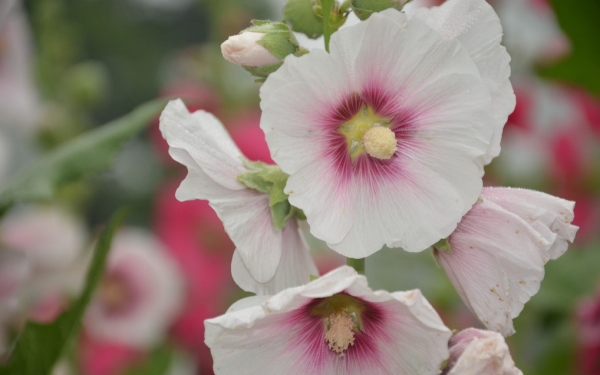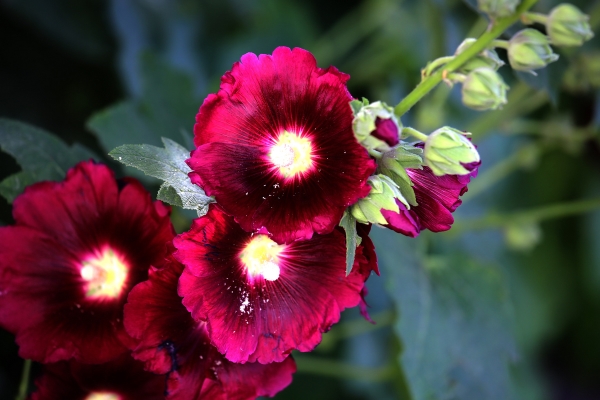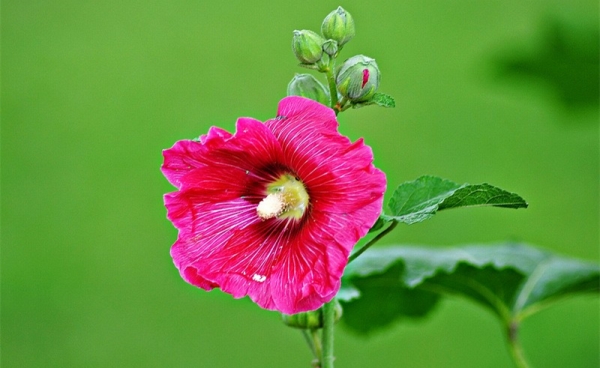Propagation methods of hollyhock
Sowing and reproduction
Hollyhock mainly uses sowing and propagation, we generally choose to carry out in autumn, choose fertile soil, and apply rotten compost in the soil as base fertilizer, sow the seeds, water to keep the soil moist, and take good measures to keep the soil moist in winter. It can take root and sprout in spring.

Ramet propagation
The ramet propagation of hollyhock was mainly carried out in spring and autumn. We dug out the perennial tufted roots and divided them into 3 buds per clump, and then planted them.
Cuttage propagation
Hollyhock cuttage propagation should be in early September, select the plant base 7 murine 8 cm long buds, cut down in the basin and placed in the semi-shade tube, after three weeks to take root, the same year can be planted in the open field, can also be moved into the indoor winter.
Comparatively speaking, the vitality of hollyhock is tenacious, as long as the temperature is suitable, hollyhock sowing can take root and sprout. And its flower language also has the meaning of "dream" and "gentle", the flower language is very beautiful not only carries the dreams of many people, but also the only choice for relatives and friends!
Propagation methods of hollyhock
Propagation method of hollyhock: sowing method
After the seeds are mature in August and September, they can be sown and blossom the following year. If they are sown in spring, it is not easy to blossom in that year. In the south, seeds are often sown in autumn, while in the north, they are mainly sown in spring.
According to the number of seeds, you can choose to sow in the open field seedbed, and then transplant, or sow directly in the soil, no longer transplant, the soil generally choose rotten leaf soil, field soil, before sowing to disinfect the soil to control the occurrence of diseases and insect pests.
Under normal circumstances, it can germinate in 7 days and transplant when 2 Mel 3 leaves are grown. It is best to transplant in cloudy and rainy days, which is very beneficial to the growth of plants.
The seed germination power of hollyhock can be maintained for 4 years, but the growth of seedlings will decline after two or three years, and the seedlings are easy to be quenched, so the management of seedling bed should be strengthened and drugs can be added to the soil properly.
Propagation method of hollyhock: split plant method
The ramet of hollyhock is usually carried out in autumn. The perennial hollyhock is dug out of the soil and the stem bud is divided into several clumps with a sharp blade to ensure that each clump has two or three buds.
Then respectively planted in the substrate, the matrix generally choose fertile, well-drained sandy soil. Water thoroughly immediately after planting, and it will blossom the following year.
Propagation method of hollyhock: cutting method
Cuttings can be carried out from flowering to winter.
Generally select the side branches that germinate at the base of the old dry hollyhock as cuttings, the length is about 8 cm, and the matrix is generally sandy soil.
After cutting, cover the nursery bed with plastic film, maintain a certain amount of humidity, and place it in the shade until the roots grow.
For cutting in winter, a heating device needs to be laid at the bottom of the seedling bed to increase the ground temperature, maintain the temperature of the seedling bed and accelerate the growth of new roots.
Culture methods of hollyhock
The cultivation and management of hollyhock is relatively simple. When the seedlings grow 2 or 3 true leaves, they should be transplanted once and the row spacing should be enlarged. Watering should be done timely after transplanting. Topdressing should be applied 1 to 2 times before flowering combined with weeding by ploughing and weeding, and phosphorus and potassium fertilizer is better. After one transplanting, the sowing seedlings can be planted in November. During the seedling growth period, 2 Mel liquid fertilizer was applied for 3 times, mainly nitrogen fertilizer. At the same time, often loosen the soil, weeding, in order to facilitate the growth of plants.
When the flower bud was formed in the axil of hollyhock leaf, the phosphorus and potassium fertilizer was applied once. In order to prolong the flowering period, sufficient moisture should be maintained. Cut off the aboveground part in time after flowering, and new buds can sprout. When potted, it should be potted in early spring and keep the single plant to blossom. As hollyhock seeds are easy to scatter after maturity, they should be harvested in time. After planting 3Mel for 4 years, the plant is easy to senescence. Therefore, it should be updated in time. In addition, hollyhock is easy to cross, in order to maintain the purity of varieties, different varieties should keep a certain distance. Hollyhocks are vulnerable to leaf rollers, aphids and red spiders, and old plants and dry weather are prone to rust, which should be prevented and controlled in time.
- Prev

Matters needing attention in cultivating hollyhock
In the process of cultivating hollyhocks, in order to prevent hollyhocks from being low and lodging, we need to use Juglans mandshurica as a cone to cut off the roots around the plant around June, cutting the roots every 2-3 weeks, and then watering immediately. It should be harvested immediately when the fruit is yellow and ripe, so as not to scatter the seeds, after the end of flowering.
- Next

Culture methods of hollyhock
Soil hollyhock has strong saline-alkali tolerance, so it is best to plant it in loose, fertile and well-drained sandy soil. Watering hollyhock has a great demand for water during flowering, so we need proper watering to keep the soil moist and promote the extension of flowering period. The suitable temperature for the growth of hollyhock is 25 to 30 degrees.
Related
- Fuxing push coffee new agricultural production and marketing class: lack of small-scale processing plants
- Jujube rice field leisure farm deep ploughing Yilan for five years to create a space for organic food and play
- Nongyu Farm-A trial of organic papaya for brave women with advanced technology
- Four points for attention in the prevention and control of diseases and insect pests of edible fungi
- How to add nutrient solution to Edible Fungi
- Is there any good way to control edible fungus mites?
- Open Inoculation Technology of Edible Fungi
- Is there any clever way to use fertilizer for edible fungus in winter?
- What agents are used to kill the pathogens of edible fungi in the mushroom shed?
- Rapid drying of Edible Fungi

